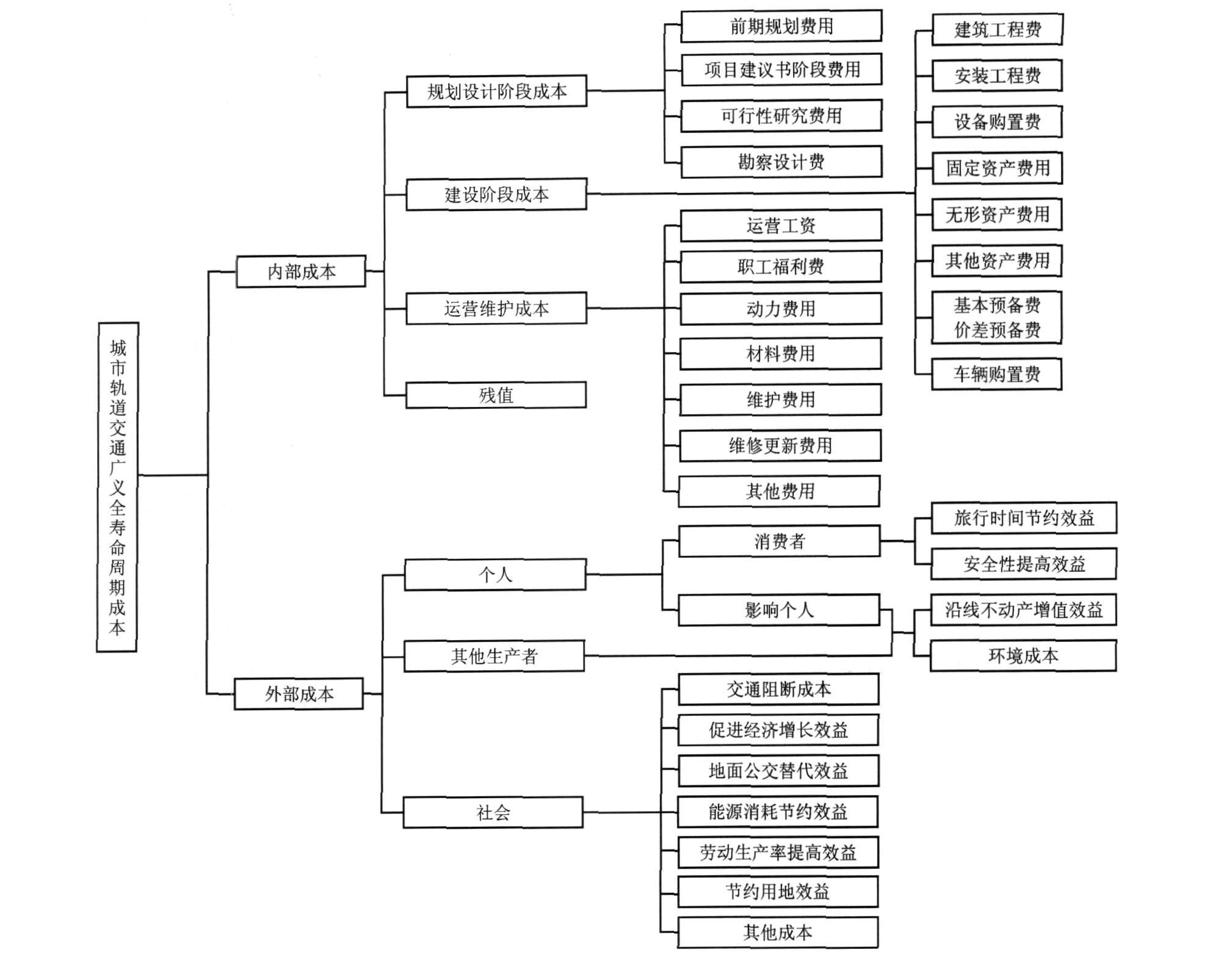-
摘要: 针对城市轨道建设方案比选和决策问题, 建立了考虑资金时间价值的城市轨道交通广义全寿命周期成本模型。分析了城市轨道交通外部成本构成, 提出了城市轨道交通阻断成本概念, 并构建了城市轨道交通阻断成本模型。以石家庄城市轨道交通1号线为例, 定量计算了城市轨道交通不同线路敷设方式广义全寿命周期成本。计算结果表明: 采用传统的全寿命周期成本评价方法, 城市轨道交通地面线的全寿命周期成本为72.16亿元, 成本最低; 引入阻断成本的广义全寿命周期成本对各方案进行评价, 地下线的广义全寿命周期成本为173.45亿元, 总成本最低, 为最优方案。Abstract: A generalized life cycle cost model was presented in order to solve the selection and decision of construction schemes for urban rail transit, and the time value of capital was considered. The external cost components of urban rail transit were analyzed, the blocking cost concept of urban rail transit was introduced, and a blocking model was developed. A case study of line 1 for Shijiazhuang urban rail transit was made, and the generalized life cycle costs of different laying modes were calculated quantificationally. Calculation result shows that the life cycle cost of line on the ground is 7.216 billion yuan according to traditional life cycle cost method, and it is lowest. The generalized life cycle cost of underground line is 17.345 billion yuan according to generalized life cycle cost method, the total cost is lowest, and the underground line is the best scheme.
-
Key words:
- urban rail transit /
- generalized life cycle cost /
- laying mode /
- external cost /
- blocking cost model
-
表 1 传统的全寿命周期成本
Table 1. Traditional life cycle costs
亿元 敷设方式 决策设计阶段成本 建设阶段成本 运营维护阶段成本 残值 传统的全寿命周期成本 地下线 3.98 132.77 36.46 0.24 173.45 地面线 1.64 54.62 15.80 0.10 72.16 表 2 运营期各年阻断成本
Table 2. Blocking cost of each year in operation period
年份 地面敷设方式阻断成本/万元 年份 地面敷设方式阻断成本/万元 2018 336 118.32 2043 118 232.09 2019 24 825.11 2044 126 666.20 2020 26 311.64 2045 135 721.84 2021 27 916.80 2046 145 444.87 2022 29 648.32 2047 155 884.59 2023 31 514.57 2048 167 093.96 2024 33 524.63 2049 179 129.86 2025 35 688.32 2050 192 053.44 2026 38 016.29 2051 205 930.37 2027 40 520.00 2052 220 831.23 2028 43 211.85 2053 236 831.84 2029 46 105.17 2054 254 013.67 2030 49 214.36 2055 272 464.24 2031 52 554.91 2056 292 277.59 2032 56 143.50 2057 313 554.77 2033 59 998.08 2058 336 404.34 2034 64 137.93 2059 360 942.94 2035 68 583.83 2060 387 295.91 2036 73 358.10 2061 415 597.90 2037 78 484.73 2062 445 993.59 2038 83 989.52 2063 478 638.46 2039 89 900.19 2064 513 699.53 2040 96 246.55 2065 551 356.28 2041 103 060.62 2066 591 801.57 2042 110 376.80 2067 635 242.61 表 3 广义全寿命周期成本
Table 3. Generalized life cycle costs
亿元 地下线 173.45 0.00 173.45 地面线 72.16 108.23 180.39 敷设方式 传统的全寿命周期成本 阻断成本 广义的全寿命周期成本 -
[1] 北京交通大学, 北京城建设计研究总院有限公司. 降低地铁造价及工程建设管理等若干问题的研究[R]. 北京: 北京交通大学, 2003.Beijing Jiaotong University, Beijing Urban Engineering Design and Research Institute Co., Ltd. General report on reducing the cost of subway construction and engineering management[R]. Beijing: Beijing Jiaotong University, 2003. (in Chinese) [2] 郭其伟, 朱瑜葱. 城市轨道交通综合效益评价体系[J]. 长安大学学报: 建筑与环境科学版, 2003, 20 (3): 63-65. https://www.cnki.com.cn/Article/CJFDTOTAL-XBJG200303019.htmGUO Qi-wei, ZHU Yu-cong. Comprehensive benefit evaluation systemof city's rail transport[J]. Journal of Chang'an University: Architecture and Environment Science Edition, 2003, 20 (3): 63-65. (in Chinese) https://www.cnki.com.cn/Article/CJFDTOTAL-XBJG200303019.htm [3] 李团社. 城市轨道交通高架敷设方式与城市发展[J]. 都市快轨交通, 2010, 23 (3): 53-55. doi: 10.3969/j.issn.1672-6073.2010.03.011LI Tuan-she. Relationship between the elevated laying mode of urban rail transit lines and city development[J]. Urban Rapid Rail Transit, 2010, 23 (3): 53-55. (in Chinese) doi: 10.3969/j.issn.1672-6073.2010.03.011 [4] 马振海. 地铁线路的敷设方式及其与工程造价的关系[J]. 铁路工程造价管理, 2004, 19 (1): 15-16, 26. https://www.cnki.com.cn/Article/CJFDTOTAL-TGZG200401004.htmMA Zhen-hai. Initial discussion on the relationship between the type of subway tracklaying and the engineering cost[J]. Railway Engineering Cost Management, 2004, 19 (1): 15-16, 26. (in Chinese) https://www.cnki.com.cn/Article/CJFDTOTAL-TGZG200401004.htm [5] 贺腊妮, 叶霞飞. 国内外城市轨道交通线路敷设方式的对比分析[J]. 城市轨道交通研究, 2011, 14 (1): 80-85. doi: 10.3969/j.issn.1007-869X.2011.01.019HE La-ni, YE Xia-fei. On route laying mode of urban mass transit[J]. Urban Mass Transit, 2011, 14 (1): 80-85. (in Chinese) doi: 10.3969/j.issn.1007-869X.2011.01.019 [6] 陆明. 对城市轨道交通高架线路的思考[J]. 综合运输, 2009 (8): 32-34. https://www.cnki.com.cn/Article/CJFDTOTAL-YSZH200908009.htmLU Ming. Thinking about the elevated lines of urban rail transit[J]. Comprehensive Transportation, 2009 (8): 32-34. (in Chinese) https://www.cnki.com.cn/Article/CJFDTOTAL-YSZH200908009.htm [7] 陈进杰, 陈峰, 梁青槐, 等. 城市轨道交通全寿命周期成本分析[J]. 交通运输工程学报, 2010, 10 (1): 82-87. doi: 10.3969/j.issn.1671-1637.2010.01.015CHEN Jin-jie, CHEN Feng, LIANG Qing-huai, et al. Whole life-cycle cost analysis of urban rail transit[J]. Journal of Traffic and Transportation Engineering, 2010, 10 (1): 82-87. (in Chinese) doi: 10.3969/j.issn.1671-1637.2010.01.015 [8] 徐岳, 武同乐. 桥梁加固工程生命周期成本横向对比分析[J]. 长安大学学报: 自然科学版, 2004, 24 (3): 30-34. doi: 10.3321/j.issn:1671-8879.2004.03.008XU Yue, WU Tong-le. Comparative analysis of life-cycle cost for bridges strengthening[J]. Journal of Chang'an University: Natural Science Edition, 2004, 24 (3): 30-34. (in Chinese) doi: 10.3321/j.issn:1671-8879.2004.03.008 [9] 吴海军, 陈艾荣. 桥梁结构耐久性设计方法研究[J]. 中国公路学报, 2004, 17 (3): 57-61, 67. doi: 10.3321/j.issn:1001-7372.2004.03.012WU Hai-jun, CHEN Ai-rong. Study of durability design method for bridge structures[J]. China Journal of Highway and Transport, 2004, 17 (3): 57-61, 67. (in Chinese) doi: 10.3321/j.issn:1001-7372.2004.03.012 [10] 牛永宁, 卢谦, 陈肇元, 等. 全寿命周期理论在建设项目决策设计阶段中的应用[J]. 建筑经济, 2007 (9): 22-25. https://www.cnki.com.cn/Article/CJFDTOTAL-JZJJ200709006.htmNIU Yong-ning, LU Qian, CHEN Zhao-yuan, et al. Application of life cycle theoryin theinception and design stages of construction projects[J]. Construction Economy, 2007 (9): 22-25. (in Chinese) https://www.cnki.com.cn/Article/CJFDTOTAL-JZJJ200709006.htm [11] 孙梅花, 宋永发, 李明阳. 轨道交通项目的外部效益分析及实例[J]. 交通科技与经济, 2009, 11 (2): 91-93. doi: 10.3969/j.issn.1008-5696.2009.02.035SUN Mei-hua, SONG Yong-fa, LI Ming-yang. Research and instantiation on the exterior economic evaluation of urban mass transit project[J]. Technology and Economyin Areas of Communications, 2009, 11 (2): 91-93. (in Chinese) doi: 10.3969/j.issn.1008-5696.2009.02.035 [12] 北京交通大学, 南京地下铁道有限责任公司. 城市轨道交通建设综合造价控制研究与示范研究[R]. 北京: 北京交通大学, 2008.Beijing Jiaotong University, Nanjing Subway Co., Ltd. Urban rail transit construction cost control research and general model[R]. Beijing: Beijing Jiaotong University, 2008. (in Chinese) [13] 谢军, 严宝杰, 张生瑞, 等. 城市环形交叉口通行能力理论模型[J]. 长安大学学报: 自然科学版, 2007, 27 (4): 75-78. doi: 10.3321/j.issn:1671-8879.2007.04.017XIE Jun, YAN Bao-jie, ZHANG Sheng-rui, et al. Theory model of circular intersection traffic capacity in urban[J]. Journal of Chang'an University: Natural Science Edition, 2007, 27 (4): 75-78. (in Chinese) doi: 10.3321/j.issn:1671-8879.2007.04.017 [14] 周伟, 李媛媛. 中国城市公共交通建设策略的理论与方法[J]. 长安大学学报: 自然科学版, 2007, 27 (4): 65-69. doi: 10.3321/j.issn:1671-8879.2007.04.015ZHOU Wei, LI Yuan-yuan. Developing theory and method of urban public trafficin China[J]. Journal of Chang'an University: Natural Science Edition, 2007, 27 (4): 65-69. (in Chinese) doi: 10.3321/j.issn:1671-8879.2007.04.015 [15] 曲丽敏, 卢忠仁. 城市道路平面交叉口渠化设计要点与分析[J]. 交通标准化, 2011 (1): 197-199. doi: 10.3869/j.issn.1002-4786.2011.01.011QU Li-min, LUZhong-ren. Key points about canalized design of crossing of urban roads[J]. Transport Standardization, 2011 (1): 197-199. (in Chinese) doi: 10.3869/j.issn.1002-4786.2011.01.011 -





 下载:
下载:




